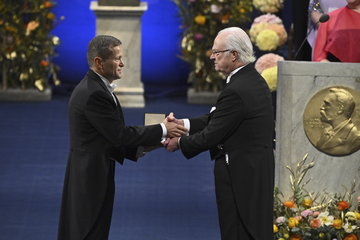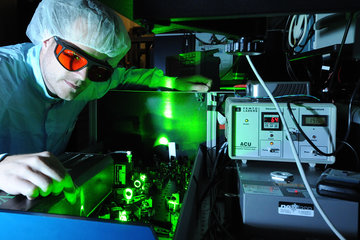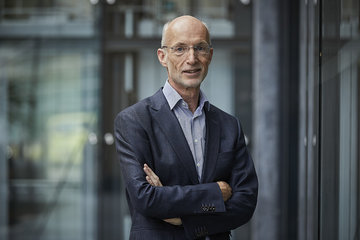Sisyphean work for polar molecules
A new method of cooling polar molecules reveals the potential to investigate gases near absolute zero
Something synonymous with unending efforts now makes possible a level of control in the microscopic realm which has never been previously attained by physicists. Optoelectrical “Sisyphus cooling”, developed by a team of scientists headed by Gerhard Rempe at the Max Planck Institute of Quantum Optics, offers the potential for the first time of cooling polyatomic molecules down to a few billionths of a degree above absolute zero, a temperature of -273.16 degrees Celsius. Atoms have been able to be cooled to such low temperatures for some time already, but it has proven to be far more difficult for molecules due to their high complexity. Yet investigations of extremely cold molecules are relevant for numerous questions in basic research. They could provide information about how chemical reactions in space take place. Moreover, ultracold molecular gases could be employed additionally as quantum simulators, or as quantum memory using cold individual molecules.

Laser light is the medium of choice for bringing atoms to extremely low temperatures. In laser cooling, atoms are exposed to laser light whose energy is very slightly below the energy of a selected excitation mode of electrons in the atom. Due to the Doppler Effect, this causes the atoms to transition from one electronic state to another only for atoms that are moving in the direction of the light beam. Ultimately, the atom is decelerated in the direction of the laser through this action. This process is the precursor for applying additional cooling techniques that finally reach the nanokelvin realm. (A Kelvin is the unit of absolute temperature that begins at absolute zero. The temperature step of one Kelvin corresponds to one degree Celsius; one nanokelvin is one billionth of a Kelvin.)
The principle of laser cooling can no longer work for polyatomic molecules as they have too many excitation modes. There are more than just the electronic excitation states – vibrational excitation modes come into play, in which the atoms oscillate against one another, together with the rotational excitation modes, which correspond to rotations of the molecule about an axis.
The dipole moment of polar molecules facilitates their cooling
Yet a majority of molecules possess another property that can be used to cool them. Due to the differing electron affinities of the atoms, charges become displaced within the molecule. For example, as is widely known, the electrons in water molecules are attracted more strongly to the oxygen atoms than to the hydrogen atoms. In this way, positive and negative regions of charge are formed. Even if such polar molecules are electrically neutral externally, they possess a pronounced electric dipole moment as a consequence. This means that their rotational levels split in a static electrical field. In what are known as Stark states that result from this, the dipoles orient themselves to differing degrees parallel or anti-parallel with the electrical field. This Stark Effect – named after the German physicist Johannes Stark – is the key to optoelectrical Sisyphus cooling.
The team headed by Gerhard Rempe, Director at the Max Planck Institute of Quantum Optics in Garching, has now applied the new cooling technique to an ensemble of approximately one million polar fluoromethane (CH3F) molecules. The particles, already pre-cooled to about 400 millikelvin, are trapped between the two plates of a capacitor whose field is very uniform in the centre, but increases sharply toward the boundary due to microstructures on the plate surface. As a consequence of the interaction of the molecular dipoles with the electrical field, their energy levels display the Stark splitting mentioned above. A cooling cycle commences when molecules in the centre of the trap are excited to a higher vibrational level by infrared radiation. From there, they transition again to the ground state and spontaneously emit photons.
At the peak of the electrical field, an RF pulse rotates the molecule

When the spontaneous emission takes place, the Stark state, directly related to the orientation of the dipole moment relative to the electrical field, can change though. “For a molecule to be successfully cooled, it must end up in a stronger anti-parallel oriented Stark state”, explains Martin Zeppenfeld, who designed the experiment as part of his doctoral dissertation and constructed it with his colleagues. “Subsequently, it must move to the boundary zone of the trap where the electrical field rises strongly.” When the molecule climbs up this gradient “hill”, a large fraction of its kinetic energy is transformed into potential energy. Near the highest point of the electrical field, the dipole moment of the molecule is intentionally rotated with suitable radio-frequency fields so that it returns to a more weakly oriented Stark state.
Since the interaction with the electrical field in the more weakly oriented Stark state is smaller, the molecule gains less energy as it rolls back down into the centre of the trap than it expended when it climbed up. “This is where the analogy to the tedious work of the mythical King Sisyphus comes in”, expounds Zeppenfeld. The cooling therefore takes place by means of the strong interaction of the dipoles with the electrical fields in the particle trap. “We are only able to cool effectively if we prevent the process from running in the opposite direction with the molecules being heated by the same mechanism”, explains Martin Zeppenfeld. The researchers accomplish this by exciting the molecules to spontaneous emission as described above, which represents a one-way street.
The cooling method could be helpful in storing quantum information
The researchers cooled the system relatively strongly with only a few repetitions of the cycle – from 390 millikelvin down to 29 millikelvin. “This technique can be applied to many different molecules, as long as they are not too large and have a strong dipole moment”, emphasises Barbara Englert, a doctoral candidate who is conducting research on this experiment. She sees potential applications for storing quantum information in the ultracold molecules, especially in conjunction with superconducting circuits.
Rosa Glöckner, also a doctoral candidate involved in the experiment, is fascinated instead primarily by the possibilities offered for the physics of many-body systems. “Our method has the potential to cool molecular gases down so strongly that we can link it to other cooling techniques, such as evaporative cooling. We could thus penetrate the nanokelvin realm necessary for the formation of a Bose-Einstein condensate.” In a Bose-Einstein condensate, the particles of an ensemble virtually coalesce into one particle because they can be described quantum-mechanically as a single particle. It would be especially interesting to investigate the behaviour of polar molecules in optical lattices since the range of the dipole interaction extends over several lattice intervals. Ultracold molecules in such a system could help investigate new kinds of quantum states in matter.
Further progress on the present path must still be negotiated before these applications become possible. “We still have a number of ways to optimise the current experiment, from improvements in the electrical trap or in the detection process for the molecules, to the utilisation of other species of molecules", says Martin Zeppenfeld. “We may thereby be able to get down to considerably lower temperatures relatively soon. But our technique already facilitates new kinds of investigations on polar molecules – from high-resolution spectroscopy to investigating collisions between molecules trapped in tuneable homogeneous electrical fields.”
OMS/PH











